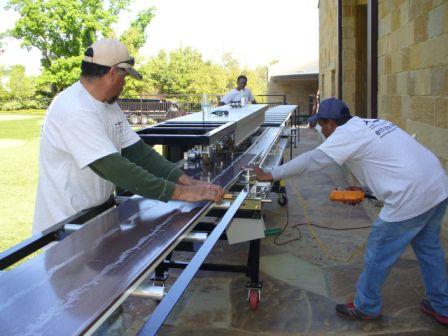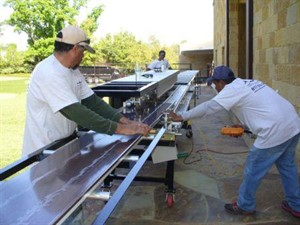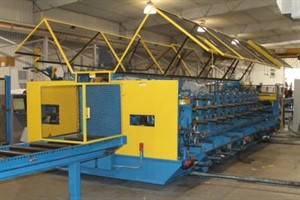Bending, Folding and Cutting Innovations
by Jonathan McGaha | 31 July 2014 12:00 am

Metal-shaping machines improve with important innovations
Innovations, increased capabilities and decreased downtime are important to any machine, especially for those that bend, fold and cut metal. This is because when companies only continue to utilize conventional processes without innovation, there is no real process advantage. Steel costs, input costs and labor costs are all approximately the same throughout the metal bending, folding and cutting industry. Also, with many manufacturers competing for the same amount of metal-shaping business, margins are often relatively low.
 Innovation via automation
Innovation via automation
Innovation via improved automation aids machines that bend, fold and cut metal by reducing labor time. “When you automate and you combine that with software that integrates the machinery into the company’s management information systems, you reduce labor costs and get this enormous improvement in productivity and ‘green light’ times,” says Geoff Stone, owner/CEO of Metalforming Inc[1]., Peachtree City, Ga. “That is the only way you can reasonably improve margins. Green light time is the amount of time during which the machine actually changes the shape of metal. This is where you as the manufacturer are adding value to the metal, whether it’s cutting, bending, rollforming or whatever. Today, industry wide, that green light time in a factory normally amounts to between 50 to 60 percent of the time available each day. If you can add two hours a day to that by automating processes that are now done manually, that adds an enormous amount of value.”
Ken McLauchlan, western regional manager, Louisville, Ky.-based
Drexel Metals[2] agrees that automation is one key innovation, especially with the user interface. “The newer machines have fully integrated computers that allow you to plan and monitor all of the usage,” he says. “Panel lengths are all programmable and the onboard system allows you to keep track of what panels have been ran and to what length.”
Peachtree City-based RAS Systems[3] stresses innovation through automation with its MultiTouch PC control. It claims programming is so simple and so intuitive that training is almost obsolete. More importantly, the knowledge of how profiles are designed and manipulated is no longer required. The operator draws the profile on the control screen monitor and the software automatically programs the part and shows several different ways to fold the part. The operator picks one and the software simulates the sequence in 2-D or 3-D view. If satisfied with the selection, the operator pushes the start button and the machine then creates the profile.

Better folding
“With this new PC control, draw your shapes to be formed right from the job site using a tablet PC,” says Rick Wester, vice president at RAS Systems. “Connect the tablet to the Internet and it can transmit the profile geometry to your office. Once there, the software calculates the cost of the profile, determines the material needed, creates the profile drawing and generates the profile data that gets sent directly to the folding machine.”
Innovative machines strive to do things faster and more efficiently than how humans do them now Part of this innovation lets them communicate to the company data systems to cut down or eliminate all the planning and time taken for programming and information gathering that destroy productivity. With metal folding, for example, if you take a standard long-folding machine, it requires multiple operators who have to turn a part “end for end” every time a bend changes direction. Operators must program every single part as they move from job one to job two. Then they’ve got to find the right bending program and read the work order to make sure they know the job.
It can be very time-consuming. “But today, it’s possible to have a long folder that grips and moves the part automatically, bends the part up and down, eliminates the safety stops and generally makes the whole process three times faster,” says Stone. “And then if you add integration software from a manufacturing execution system, you can totally eliminate all of the planning, programming, data gathering and button pushing on the machine to dramatically increase your green light time.”
Farmington Hills, Mich.-based Van Mark Products Corp.[4] enhances performance and productivity by allowing metal contractors to bend, fold and cut most of the pieces needed right on the job site. “While many pieces will typically be formed off-site and shipped to the job, there are usually many small pieces that need to be bent, folded or cut to fit specific sizes and needs unique to the job,” says Van Mark’s director of sales and marketing Gary Weinert. “Both innovations in CAD software and the new 3-D printers available today allow us to model parts more efficiently, reducing typical R&D timelines and bringing finished products to market sooner.”
Innovations in speed
Customers are continually challenging metal-shaping manufacturers to provide faster production. To answer this challenge, many companies have developed metal panel-shaping lines that operate at speeds in excess of 300 feet per minute (FPM). A 300 FPM line has the potential to annually produce up to 15 to 20 million lineal feet of finished product in a single production shift.
But it requires some innovative equipment to do this. A typical metal panel line encounters congestion during the loading and unloading of steel coils from the uncoiler. Most manufacturers are required to change coils 20 to 25 times per production shift. A traditional setup will require an operator to load and unload coils one at a time, which creates unnecessary downtime.
 To address this challenge, Moundridge, Kan.- based Bradbury Co. Inc.[5] customers incorporate an innovative coil loading car and a double mandrel uncoiler. The double mandrel uncoiler has one mandrel in-line and one mandrel available to accept the next coil of steel. “For example, if an operator is running a project that requires 1,500 pounds of burgundy-colored panels and 1,500 pounds of white-colored panels, the operator can rotate the uncoiler to allow the proper coil to be run, while the other coil is removed and the next required coil is loaded and ready to run,” says Ben Schmidt, industry sales leader-metal buildings, trim and decking at Bradbury. “The double mandrel uncoiler is one of the most highly recommended features when speaking with existing manufacturers of metal building panels.”
To address this challenge, Moundridge, Kan.- based Bradbury Co. Inc.[5] customers incorporate an innovative coil loading car and a double mandrel uncoiler. The double mandrel uncoiler has one mandrel in-line and one mandrel available to accept the next coil of steel. “For example, if an operator is running a project that requires 1,500 pounds of burgundy-colored panels and 1,500 pounds of white-colored panels, the operator can rotate the uncoiler to allow the proper coil to be run, while the other coil is removed and the next required coil is loaded and ready to run,” says Ben Schmidt, industry sales leader-metal buildings, trim and decking at Bradbury. “The double mandrel uncoiler is one of the most highly recommended features when speaking with existing manufacturers of metal building panels.”
To keep speeds up, Burlington, Ontario, Canada-based AXYZ International’s[6] PanelBuilder V13 has a library of parametric templates, fully automated sheet nesting and optimized programming for efficient cutting on its AXYZ Series CNC Router. But its most innovative capability is its ability to run in Pendulum Processing mode. “This takes advantage of an extra-long process area to accommodate two full-size sheets of raw material which are processed one after the other,” says Robert Marshall, vice president of market development at AXYZ International. “As one sheet is being cut, the other is unloaded and reloaded to allow true continuous production. This is a massive timesaver on large projects which may require many hundreds of panels to be produced.”
Denver-based New Tech Machinery’[7]s tapered slitter machine (TSM) and tapered panel machine (TPM) work in tandem on jobs that require tapered metal panels or nontraditional metal panel widths. To safely accommodate accelerated speeds, New Tech Machinery has built-in innovative features for all its equipment. “TSM offers a hands-free foot controller which allows the user to have both hands free to complete the task of properly slitting the material,” says Tom Laird, sales manager at New Tech Machinery. “The TPM offers a pendant controller which again allows operation from a distance if needed.”
Innovation inspiration
Without metal-shaping machines and their many innovations, this type of work would need to be done manually. “This is time consuming and more prone to be done incorrectly,” cautions Kristin Peregoy, marketing manager at New Tech Machinery. “While machines do carry an upfront cost, they will pay for themselves over and over in terms of saving time, hours at the job site and accuracy that doesn’t need to be redone.”
Where do all metal-shaping innovations originate? McLauchlan contends most come straight from the end user. “Innovations are brought around by contractors or our customers expressing their needs and being willing to talk with their partners in the industry about them,” he says. “Do not be afraid of a process of expressing your needs as if one has an issue, others will or likely have the same issue. We will all grow from the opportunity.”
Sidebar: Metal-shaping innovation expectations
Where will innovations lead us 10 years from now?
Machinery that allows for quicker changeover between profiles, and reduced costs of machinery as technology and process improvements allow the contractor to work on more profiles and projects. Ken McLauchlan, western regional manager, Drexel Metals
Ten years from now, the automation and software integration the industry is starting to embrace now will be standard. Further down the road, I can see us eliminating most operators altogether with robots. Geoff Stone, owner/CEO, Metalforming Inc.
In the future we see further automation that will eliminate even more involvement from the operator. Automatic loading and unloading of parts are not that far away. Rick Wester, vice president, RAS Systems
The ability to add value to a coil of steel is the founding principle of rollforming. This process will continue to be a significant driver of future innovations. Ben Schmidt, industry sales leader-metal buildings, trim and decking, Bradbury Co. Inc.
- Metalforming Inc: http://www.metalforming-usa.com
- Drexel Metals: http://drexmet.com
- RAS Systems: http://www.ras-systems.com
- Van Mark Products Corp.: http://www.van-mark.com
- Bradbury Co. Inc.: http://www.bradburygroup.com
- AXYZ International’s: http://axyz.co.uk
- New Tech Machinery’: http://www.NewTechMachinery.com
Source URL: https://www.metalconstructionnews.com/articles/bending-folding-and-cutting-innovations/